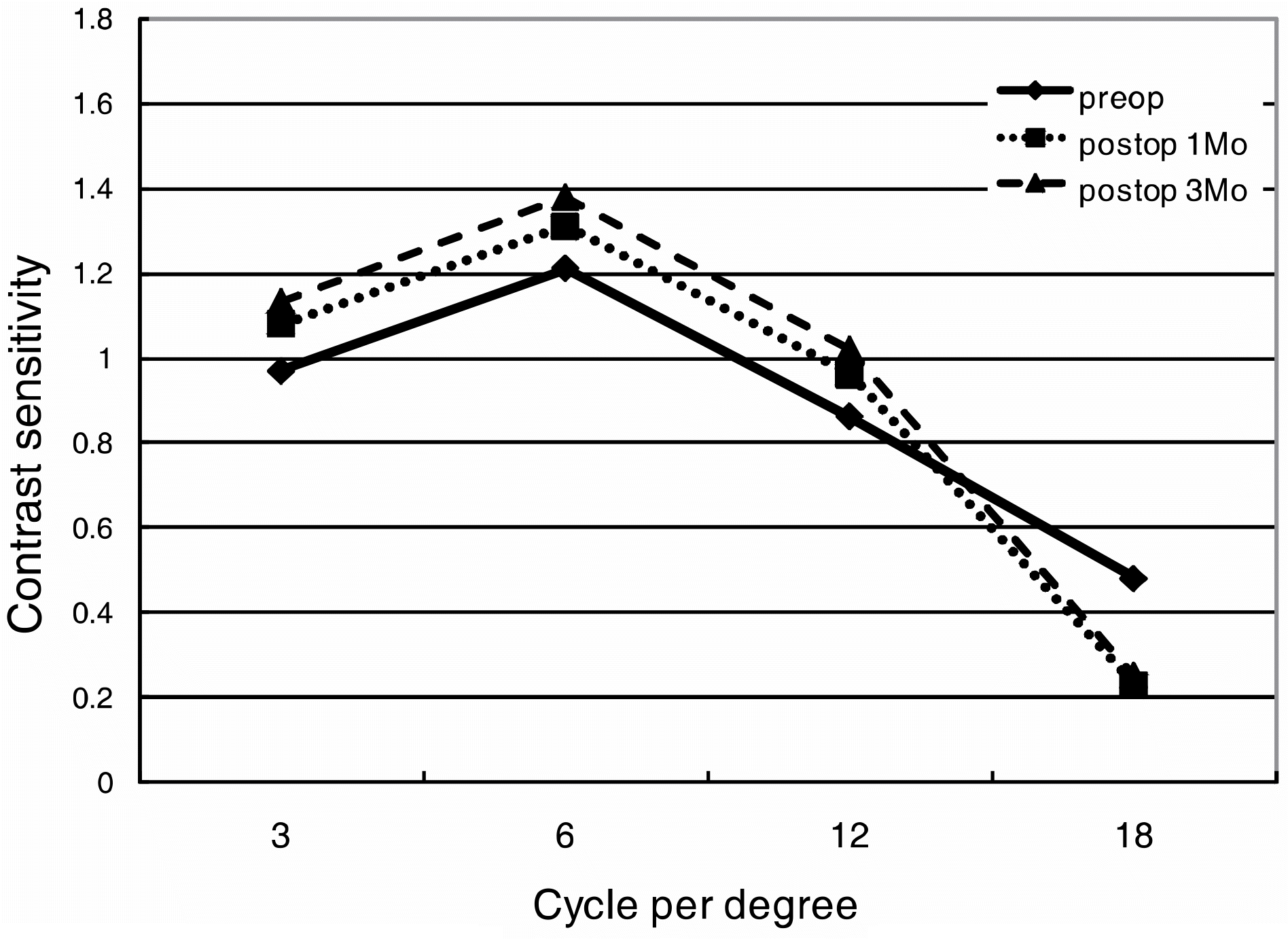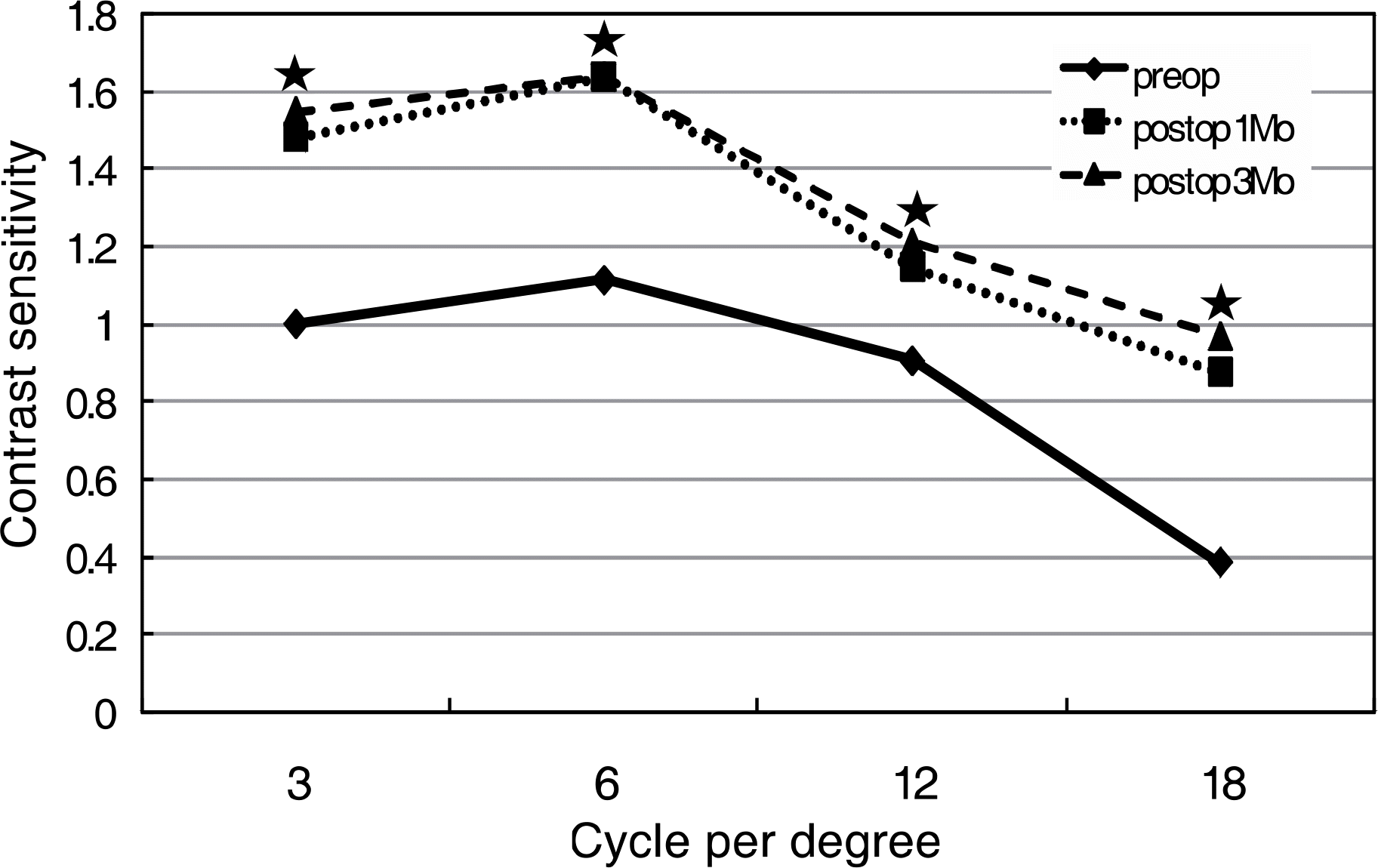Abstract
Purpose
To compare postoperative visual acuity, spherical equivalent and contrast sensitivity of eyes implanted with either spherical C-flex TM(570C) or aspheric C-flex TM(970C) intraocular lenses (IOL).
Methods
Forty eyes implanted with posterior chamber intraocular lenses were divided into two groups: C-flex TM(570C) (20 eyes) and C-flex TM(970C) (20 eyes). In these two groups, postoperative best corrected visual acuity (logMAR), spherical equivalent and contrast sensitivity was performed at one month and three months, postoperatively.
Results
In the spherical group, the preoperative naked visual acuity was 1.25±0.46 (logMAR). The best corrected visual acuity at postoperative three months was 0.49±0.28. In the aspheric group, the preoperative naked visual acuity was 1.29±0.67. The best- corrected visual acuity at postoperative three months was 0.39±0.30. There were statistically significant differences in best-corrected visual acuity between the preoperative and the postoperative three months results in the spherical IOL group and in the aspherical IOL group. There were no statistically significant differences in spherical equivalent between preoperative and postoperative one- month results and between preoperative and postoperative three-month results in the spherical IOL group and the aspherical IOL group. In the aspherical IOL group, contrast sensitivity at postoperative one and three months were better in the all spatial frequency than in the preoperative scotopic condition.
Conclusions
When we compared eyes implanted with the spherical C-flex TM(970C) with eyes implanted with the spherical C-flex TM (570C), there were no statistically significant differences in spherical equivalent or best corrected visual acuity. The aspherical IOL group showed better contrast sensitivity than did the spherical IOL group postoperatively at both one month and three months.
References
1. Barbero S, Marcos S, Jime´nez-Alfaro I. Optical aberrations of intraocular lenses measured in vivo and in vitro. J Opt Soc Am A Opt Image Sci Vis. 2003; 20:1841–51.

2. Holladay J, Piers P, Koranyi G, et al. A new intraocular lens design to reduce spherical aberration of pseudophakic eyes. J Refract Surg. 2002; 18:683–91.

3. Denoyer A, Denoyer L, Halfon J, et al. Comparative study of aspheric intraocular lenses with negative spherical aberration or no aberration. J Cataract Refract Surg. 2009; 35:496–503.

4. Owsley C, Sekuler R, Siemsen D. Contrast sensitivity throughout adulthood. Vision Res. 1983; 23:689–99.

5. Glasser A, Campbell M. Presbyopia and the optical changes in the human crystalline lens with age. Vision Res. 1998; 38:209–29.

6. Artal P, Berrio E, Guirao A, Piers P. Contribution of the cornea and internal surfaces to the change of ocular aberrations with age. J Opt Soc Am A Opt Image Sci Vis. 2002; 19:137–43.

7. Smith G, Cox MJ, Calver R, Garner LF. The spherical aberration of the crystalline lens of the human eye. Vision Res. 2001; 41:235–43.

8. Guirao A, Redondo M, Artal P. Optical aberrations of the human cornea as a function of age. J Opt Soc Am A Opt Image Sci Vis. 2000; 17:1697–702.

9. Lin IC, Wang IJ, Lei MS, et al. Improvements in vision-related quality of life with AcrySof IQ SN60WF aspherical intraocular lenses. J Cataract Refract Surg. 2008; 34:1312–7.

10. Luis C, Ana I, Alberto O, et al. Postoperative Optical Aberrations in Eyes Implanted With AcrySof Spherical and Aspheric Intraocular Lenses. J Refract Surg. 2008; 24:811–6.

11. Packer M, Fine IH, Hoffman RS, Piers PA. Improved functional vision with a modified prolate intraocular lens. J Cataract Refract Surg. 2004; 30:986–92.

12. Muñoz G, Albarrán-Diego C, Montés-Micó R, et al. Spherical aberration and contrast sensitivity after cataract surgery with the Tecnis Z9000 intraocular lens. J Cataract Refract Surg. 2006; 32:1320–7.

13. Rocha KM, Soriano ES, Chalita MR, et al. Wavefront Analysis and Contrast Sensitivity of Aspheric and Spherical Intraocular Lenses. Am J Opthalmol. 2006; 142:750–6.
14. Pandita D, Raj SM, Vasavada VA, et al. Contrast sensitivity and glare disability after implantation of AcrySof IQ Natural aspherical intraocular lens: Prospective randomized masked clinical trial. J Cataract Refract Surg. 2007; 33:630–10.
15. Tzelikis PF, Akaishi L, Trindade FC, Boteon JE. Ocular aberrations and contrast sensitivity after cataract surgery with AcrySof IQ intraocular lens implantation. J Cataract Refract Surg. 2007; 33:1918–24.

16. Caporossi A, Martone G, Casprini F, Rapisarda L. Prospective randomized study of clinical performance of 3 aspheric and 2spherical intraocular lenses in 250 eyes. J Refract Surg. 2007; 23:639–48.
Figure 1.
The value of contrast sensitivity by C-flex TM (570C) between preoperative and postoperative 1 and 3 months.

Figure 2.
The value of contrast sensitivity by aspheric C-flex TM(970C) between preoperative and postoperative 1 and 3 months (★p<0.05). The contrast sensitivity in scotopic condition at postoperative 1 month and 3 months is shown better at the all spatial frequencies than at preoperative period.

Table 1.
Dermographics of study group C-flex TM(570C) and group C-flex TM(970C)
| C-flex TM(570C) | C-flex TM(970C) | |
|---|---|---|
| Eyes/Patients (cases) | 20/19 | 20/18 |
| Sex (M/F, cases) | 6/14 | 12/8 |
| Age (years) | 62.60±14.83 | 64.50±11.97 |
| Preop V/A* (logMAR) | 1.29±0.67 | 1.25±0.46 |
| Postop 3 month V/A (logMAR) | 0.39±0.30 | 0.49±0.28 |
| p-value† | 0.020 | 0.001 |
| Preop SE‡ | -1.12±3.67 | -1.65±3.72 |
| Postop 3 month SE | -0.93±1.06 | -0.63±0.59 |
| p-value§ | 0.338 | 0.459 |
Table 2.
Preoperative and postoperative contrast sensitivity of study groups C-flex TM(570C) and C-flex TM(970C)
| C-flex TM(570C) | C-flex TM(970C) | |
|---|---|---|
| Preoperative CST* | ||
| 3 cpd† | 0.97±0.21 | 1.00±0.24 |
| 6 cpd | 1.21±0.19 | 1.12±0.28 |
| 12 cpd | 0.86±0.18 | 0.91±0.17 |
| 18 cpd | 0.48±0.18 | 0.39±0.22 |
| Postoperative 1 month CST | ||
| 3 cpd | 1.08±0.31 (0.611)‡ | 1.48±0.21 (0.001)‡ |
| 6 cpd | 1.31±0.26 (0.223)‡ | 1.60±0.25 (0.003)‡ |
| 12 cpd | 0.96±0.14 (0.141)‡ | 1.15±0.09 (0.001)‡ |
| 18 cpd | 0.23±0.31 (0.137)‡ | 0.88±0.18 (0.001)‡ |
| Postoperative 3 month CST | ||
| 3 cpd | 1.13±0.28 (0.189)§ | 1.55±0.22 (0.002)§ |
| 6 cpd | 1.38±0.22 (0.123)§ | 1.64±0.26 (0.003)§ |
| 12 cpd | 1.02±0.16 (0.062)§ | 1.21±0.13 (0.001)§ |
| 18 cpd | 0.25±0.25 (0.184)§ | 0.97±0.21 (0.002)§ |




 PDF
PDF ePub
ePub Citation
Citation Print
Print


 XML Download
XML Download